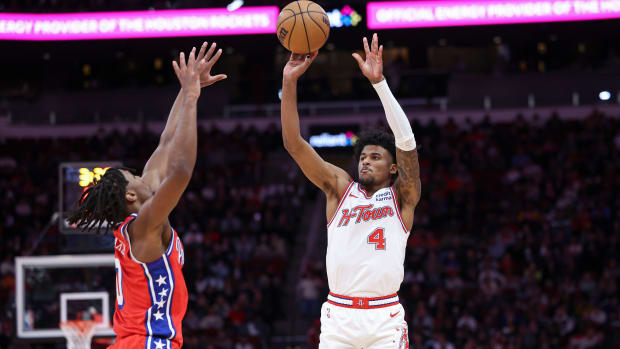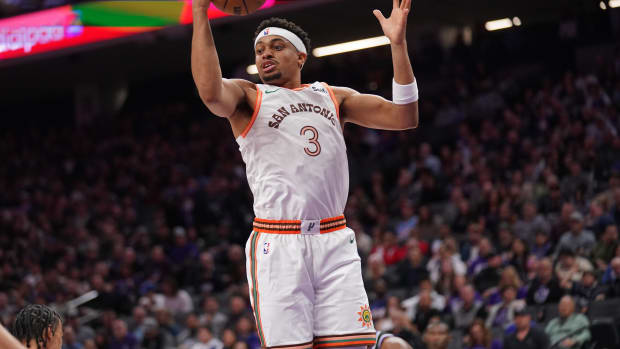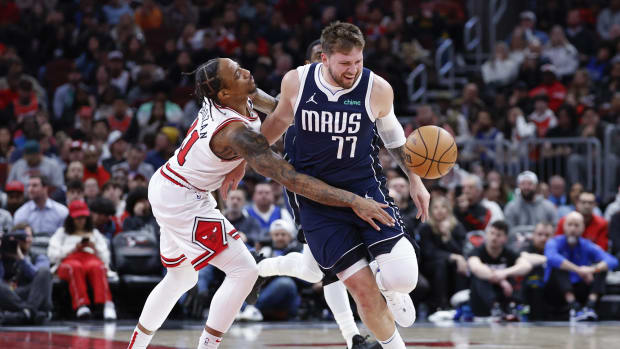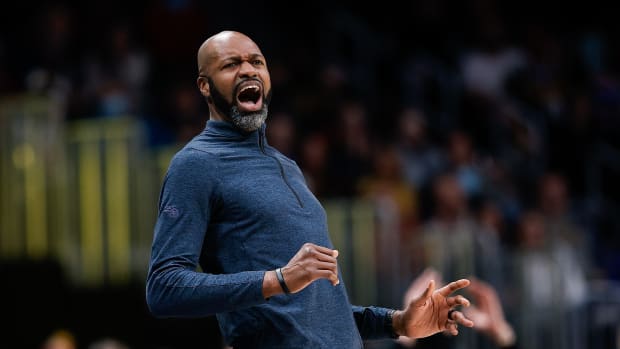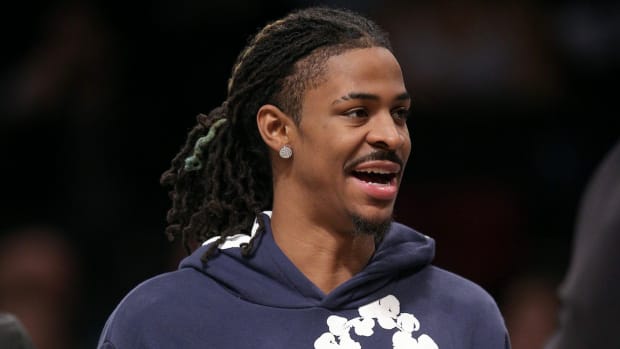Timberwolves face historic three-point void after Kevin Love trade
The August trade of Kevin Love was supposed to vault the Cavaliers into the championship discussion while launching yet another rebuilding cycle for the Timberwolves. As Cleveland prepares to host Minnesota on Tuesday in the first post-trade meeting of the two teams, the jury remains out on the first prediction: the Cavaliers (16-10) sit in the middle of the East's playoff pack, and their up-and-down start doesn't exactly have the league's premier teams quaking in their boots.
The Timberwolves (5-21), however, have sunk hard and fast, right on schedule. Given that they enter Tuesday's action with the West's worst record -- trailing the No. 14 seed Lakers by 2.5 games -- perhaps their freefall was even harder and faster than expected. How bad are things? Minnesota is currently the only team to have a bottom-five offense (No. 27) and a bottom-five defense (No. 29). Injuries to Ricky Rubio, Kevin Martin and Nikola Pekovic have also combined to make Minnesota significantly less competitive while also stripping away a lot of the fun factor; the Timberwolves are 1-11 in their last 12 games (with a league-worst -12.7 net rating since Nov. 30), and they are currently tied with the hapless Sixers (3-23) for the league's worst overall net rating (-11.2). Things are very bad.
There are a ton of problem areas for the Timberwolves, particularly in their injury-depleted state. A good chunk of coach Flip Saunders' rotation is comprised of prospects -- Andrew Wiggins, Zach LaVine, Shabazz Muhammad, Gorgui Dieng, and Anthony Bennett -- who are learning on the job. This week's trade of veteran wing Corey Brewer to the Rockets for 23-year-old Troy Daniels suggests that a sell-off of veterans is playing out as expected and likely to continue prior to the trade deadline. In this environment, it's clear that Minnesota misses Love in all sorts of ways: as a lead scoring option, as a dependable night-to-night producer, as a high-volume rebounder, as an experienced player entering his prime, and as a versatile player with the ability to beat defenses from both inside and out.
Sports Illustrated's 25 most popular stories of 2014
Perhaps the Timberwolves' most heinous wart is how badly they have been getting killed in the three-point game since Love's departure. Simply put: Minnesota's performance from outside the stripe -- comparing its three-point offense to its three-point defense -- has been historically bad.
How many times have you watched a basketball game and heard the color commentator highlight "making more threes than the opponent" as one of the pre-game keys to victory? This is an obvious, oft-mentioned goal for good reason: the three-pointer has become increasingly central to NBA offenses in recent years, and a team's three-point differential is usually a pretty reliable measure of its overall effectiveness.
As the chart below shows, 11 of this season’s top 13 teams by net rating average more three-pointers made than their opponents, while the seven worst teams by net rating all average less threes than their opponents. No wonder shooters like Kyle Korver and "shooters" like Jodie Meeks cash out every summer.
Note: the x-axis of this chart represents three-point differential (the number of made three-pointers a team averages per game compared to its opponent) and the y-axis represents a team's net rating.
(Click here to enlarge)
The Love-less Timberwolves rank dead last in three-point differential. By a mile. By so much, in fact, that they have a shot to lose the three-point line by a wider margin than any team from the last 10 years.
Let’s take a look at the numbers.
Entering Tuesday, Minnesota ranked dead last in both three-point makes (4.4) and attempts (13.2) per game, and it's 33.4 percent shooting from outside ranked 23rd. At the same time, Minnesota’s defense ranked tied for 22nd in opponent threes conceded (8.3) and 27th in opponent three-point percentage (21.9).
All told, the Timberwolves have made more three-pointers than their opponent in just three of their 26 games and just once in the last month (against Byron Scott's Lakers). As if that wasn’t bad enough, consider: in back-to-back blowout losses to the Blazers (Nov. 30) and Clippers (Dec. 1), the Timberwolves somehow managed to shoot 4-21 (19 percent) combined while allowing 27-for-67 (40.3 percent) combined from deep. In less than 30 hours, Minnesota conceded 69 more points from outside than it scored! Picture Saunders on the sideline, firing a squirt gun in response to bazooka blasts.
Examining potential suitors for Josh Smith following his stunning release
SI.com has detailed Love's place in the long line of impact stretch forwards, and his departure looms very large here. After all, he led the Timberwolves in three-pointers made in both 2011-12 and 2013-14 and his replacement, Thaddeus Young, isn't much of an outside threat (7-for-27 from deep on the season). Even though Martin hasn’t played in more than a month, he somehow remains Minnesota’s leader with 26 three-pointers this year. By comparison, Love has hit a team-high 44 threes for Cleveland, and both of his new All-Star teammates (LeBron James and Kyrie Irving) have made more threes than Martin.
What happens when Minnesota’s league-worst three-point attack and its below-average three-point defense converge? The result is a minus-3.9 three-point differential, meaning that the Timberwolves give up nearly four more three-pointers more than they make, every single game. To really drive this home: Minnesota will lose the three-point line by nearly 12 points on any given night. Although the Timberwolves were hardly world-beaters from beyond the arc last season, their 2013-14 three-point differential was a more respectble minus-0.8 thanks largely to Love (190 threes) and Martin (115 threes).
If the chart above hadn't already made it clear, the Timberwolves are currently in a really, really deep ditch relative to the rest of the league. Here’s a look at the top-five and bottom-five in this category so far this season.
Five Best Three-Point Differentials: 2014-15
- Rockets: +5.3
- Blazers: +4.2
- Suns: +3.1
- Warriors: +3
- Clippers: +1.9
Five Worst Three-Point Differentials: 2014-15
- Timberwolves: -3.9
- Grizzlies: -2.9
- Kings: -2.8
- Lakers: -2.4
- Hornets: -2.4
As a point of reference, 19 of the NBA’s 30 teams have a three-point differential between -1.5 and 1.5. In other words, a majority of the league’s teams are pretty tightly packed when it comes to the three-point line. Minnesota, clearly, is out there on an island right now.
Taking this one step further, a look back at recent history reveals that Minnesota -- if it maintained its current pace -- would lose the three-point line by a greater margin than any team from the last 10 seasons.
Worst Three-Point Differentials: 2005-06 through 2014-15
- 2014-15 Timberwolves: -3.9 | Record: 5-21 (in progress)
- 2007-08 SuperSonics: -3.6 | Record: 20-62
- 2010-11 Grizzlies: -3.4 | Record: 46-36
- 2008-09 Wizards: -3.4 | Record: 19-63
- 2007-08 Sixers: -3.1 | Record: 40-42
- 2008-09 Sixers: -3.0 | Record: 41-41
- 2012-13 Bobcats: -3.0 | Record: 21-61
- 2005-06 Knicks: -3.0 | Record: 23-59
- 2005-06 Hornets: -3.0 | Record: 38-44
Minnesota finds itself in some interesting company, and will likely join the 2008 Sonics (Kevin Durant’s rookie year), the 2009 Wizards (Gilbert Arenas played just two games), the 2013 Bobcats (the first team after missing out on Anthony Davis in the draft), and the 2006 Knicks (one of president Isiah Thomas’s many catastrophes) by finishing the season among the league’s very worst teams.
The Grizzlies of recent years have regularly proven to be a rare exception in this discussion, as they have overcome their perimeter shooting weaknesses by playing strong overall defense and by relying on an interior attack (headed up by the fearsome duo of Marc Gasol and Zach Randolph). Saunders, with such a young roster and without much low-post dynamite in Pekovic's advance, can’t exactly turn to Memphis for inspiration.
Want to avoid injury? NBA teams are looking to Marcus Elliott for answers
Martin’s eventual return from wrist surgery and the arrival of Daniels, who caught on in Houston thanks to his outside shooting, could help Minnesota avoid history and draw a little bit closer to respectability. It's also possible that youngsters like Wiggins and Muhammad could provide more from deep once Rubio returns to the court as a set-up man. The Timberwolves could also progress to the mean as their sample size continues to enlarge.
For now, this glaring weakness falls in Saunders’ lap twice over because he serves as both the Timberwolves’ coach and general manager. Other coaches, facing similar shortcomings, haven’t fared well at all. Shortly into the 2008-09 season, the Sonics (by then the Thunder) fired coach P.J. Carlesimo. The Wizards fired coach Eddie Jordan early in 2008-09 and they didn’t retain his interim replacement for 2009-10. Maurice Cheeks was fired midway through the 2008-09 season in Philadelphia and his interim replacement wasn't retained. The Bobcats fired coach Mike Dunlap after the 2012-13 season. Thomas took over the Knicks’ coaching reins from Larry Brown in 2006-07. You get the picture.
Minnesota’s youth movement allows Saunders the GM to give Saunders the coach a looser leash than many of his colleagues have enjoyed in the past. However, maybe this serious, systemic deficiency should encourage Saunders to undertake another coaching search during the offseason. The post-Love roster needs some heavy, heavy lifting; one injury, like Martin’s, should never single-handedly submarine a team to historic perimeter impotency. Saunders and Timberwolves owner Glen Taylor must ask themselves (again) whether the guy doing the lifting should be the same guy who molds the assembled parts on a day-in, day-out basis.
































